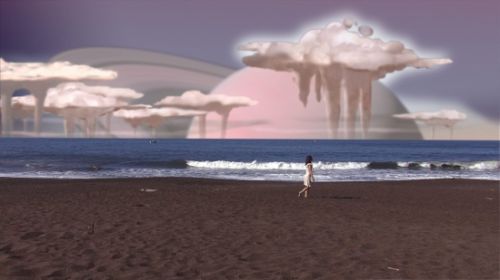
Jillian Mcdonald / Video Still: Zombie Apocalypse
Jillian McDonald "Monstrosities" at Michael Rosenthal Gallery
365 Valencia street, San Francisco (View Map), 415.552.1010
Jun 20 - Jul 23, 2009
Join the conversation about this show:
Never miss another show: sign up for free weekly updates
San Francisco, May 2009 - Opening Saturday, June 20th at Michael Rosenthal gallery is the premiere of Canadian-born, international video artist Jillian Mcdonald's Zombie Apocalypse filmed at The headlands Center for the Arts, alongside three other video works and a series of lenticular photos, all of which comprise Mcdonald's upcoming exhibition Monstrosities.
Zombie Apocalypse, video, 2009
Premiering at Michael Rosenthal Gallery, Zombie Apocalypse is a re-imagined final scene from the 1985 New Zealand film "Quiet Earth". In Mcdonald's video, a woman on the beach is 'zombified' by an unknown force that also causes beautiful atmospheric meltdown, over and over again.
Vampire Hunt, 2-channel video installation, 2007
The vampire, although undead, lives a rich immortal life, and is cloaked in a mythology that is simultaneously erotic, intriguing, and infinitely mysterious. In this installation, projections on two opposing walls position the viewer in the center of a visual loop, wherein a hungry vampire endlessly pursues a damsel in distress. On screen, the artist plays both roles.
The vampire, prepared with horror make-up and seen from the front, stalks its prey, our heroine, who has already received a fang bite. The heroine slips through the forest hiding and glancing over her shoulder, ever aware of the imminent danger as the camera follows her. Her predator has already been wounded by a stake to the heart. In the scenarios, filmed in a pine forest in Southern Wisconsin, it is obvious that vampire and heroine are somehow the same, referencing the genre's implied life-cycle where the living become the undead and the undead survive only by drinking from the living.
Chronological time is confused, and the narrative is non-linear. The vampire is hunting, and also being hunted. The tracks are projected simultaneously and the sequences looped continuously, which locates the viewers physically between the two roles and positions them as both the prey just out of reach of danger, and the pursuer hungering for its victim.
The Screaming, video, 2007
The sound of a startling scream is a device used across film genres, but particularly in horror, to effectively ensure the viewer has not slipped into a state of comfort or complacency. Just when the coast has cleared, the monster rises again for one more stab or bite at the collective horror nerve. Accompanying this visual lurch is often a piercing scream by a protagonist female, the sound of which amplifies and suspends the horrifying effect, rendering it visceral.
The scream is an outward sign that the character in the film has lost her calm, and a signal to viewers that perhaps they ought to scream too. Mcdonald inserts herself into scenes from well-known horror films from the 1970s onward. Her presence serves not as a self-portrait but as a zone of fantasy, where her protagonist screams at the horror not out of helpless fear, but with a powerful, sometimes destructive force that scares or even blows the monsters away.
Writes Trent Morse on Mcdonald's work for The Saatchi Gallery Daily Magazine:
"Mcdonald reverses traditional roles of killer and victim by defeating her tormentors with piecing screams. Early in the video, she seems surprised when her shrieks cause villains, such as Michael Myers from Halloween or Freddy Krueger from A Nightmare on Elm Street, to fearfully retreat. Towards the end, however, she revels in her power and becomes a killer in her own right, culminating in a scream that prompts the fiery explosion of a bloblike creature from the B-movie Slither. Mcdonald's shrieking character is an empowered woman using her presumed weakness as a sonic bludgeon, but always in a humorous way. The brevity of the movie clips, removed from their plots and storylines, exaggerates the silliness of these horror films. Each time I saw the video, Mcdonald's grossed-out reactions to her conquered enemies elicited grins and even out-loud laughter from gallery goers, a rarity in an art world that sometimes takes itself too seriously."
Horror Makeup, video, 2006
In "Horror Make-up" Mcdonald, transforms herself from a normal person to a zombie in the midst of a daily New York subway commute. Instead of improving her features, like the woman who steadily applies makeup en route to work or play, Mcdonald becomes gruesome. This work takes cues from the legion of women who perform beauty rituals on the subway in a curious private zone where they seem unaware of anything outside their activity, and the rising cult of zombies in popular culture, where zombie gatherings and zombie lore flourish. Locating the audience physically in the subway performance space positions them as both voyeurs and potential victims.
*During this video filming Mcdonald was shadowed by a New York Times reporter.
NOTE: In celebration of the exhibition's opening, the gallery's public reception on Saturday, June 20th will feature free zombie make-up station with local artists from 4-9pm.
Zombie Portraits, lenticular photographs, 2007
In Mcdonald's lenticular photographs, ordinary people are transformed into zombies before the viewer's eyes! This work exposes the artifice of the horror makeup, at once softening the frightening effect and triggering humor. The images are lenticular, meaning that ribbed surface lenses reflect the images beneath them so that as the viewer's point of view changes, the viewed image changes - creating the illusion of movement. In effect these are interactive animations.
Please contact Michael Rosenthal Gallery for additional information.
Return to Artcards San Francisco »
Return to Artcards San Francisco »